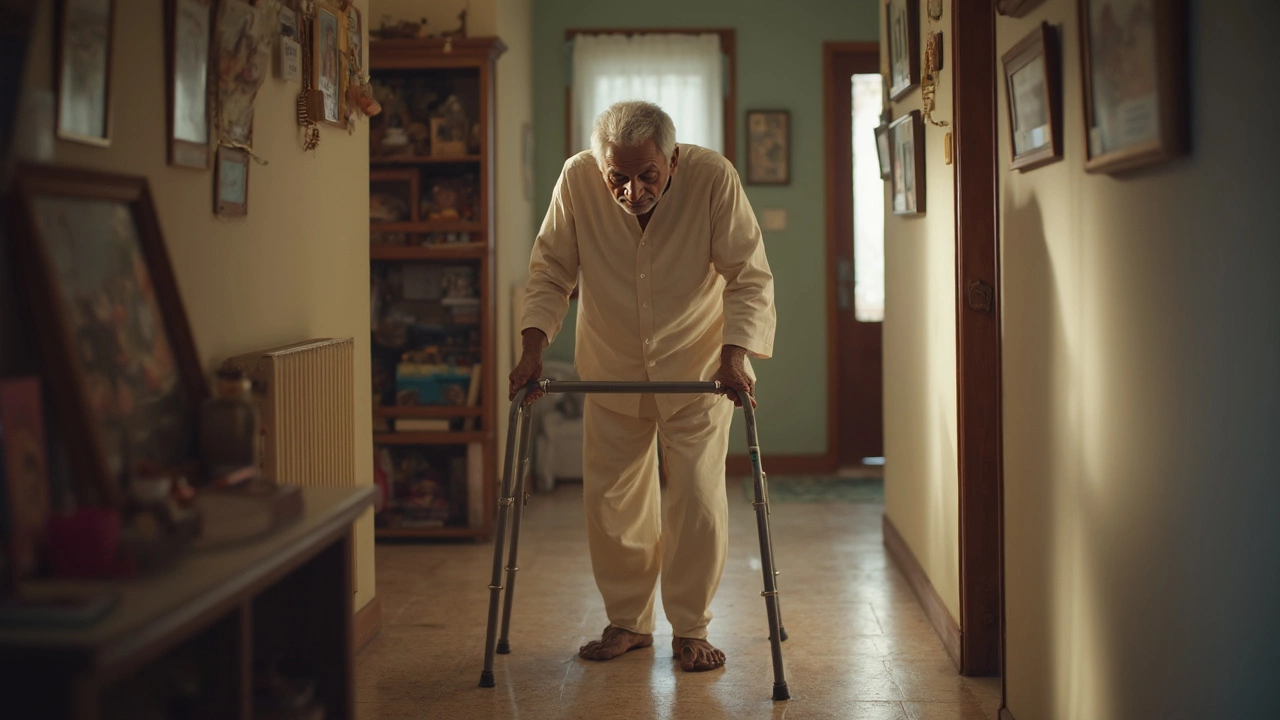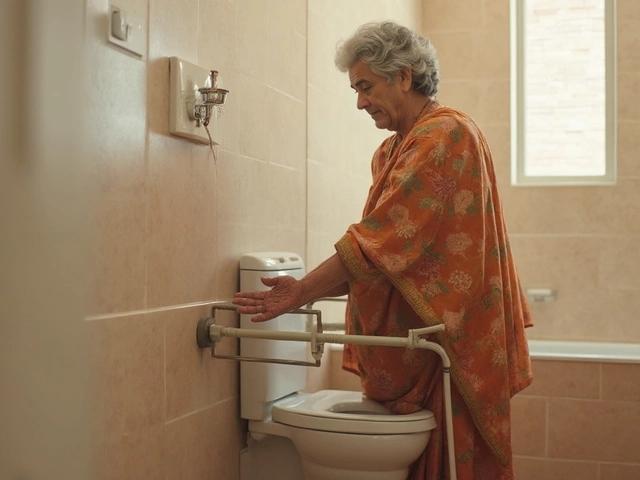
Picture this: You're sitting in the waiting room, nervously flipping through old magazines, half-listening as the nurse calls out names. The doctor promised the surgery would give your knee 'a new lease on life.' But what if I told you the real story starts after the operation? There’s a whole world nobody really prepares you for—one that can catch even the savviest patients completely off guard.
Behind the Hype: The Reality of Living With a New Knee
If you trust a search engine or the slick brochures at your GP, knee replacements are a miracle fix. Get the surgery, do your physio, and—boom—you're hiking the Brecon Beacons by Christmas. But here’s the bit most folks skip: your new knee is part metal, part plastic, and entirely a learning curve. The phrase nobody likes to say out loud? It’s never going to feel like your old knee, not even close. It’s not magic. Sometimes it’s not even immediate pain relief.
Right after your surgery, you’ll realise your knee feels unnaturally swollen, stiff, and wooden—like someone slipped in a brick where bone should be. The first few days are a cocktail of weird sensations. The skin tingles as the nerves wake up. Then, there’s 'the click.' Every patient post-knee replacement knows this one. The artificial joint often makes a tiny clicking or popping sound—especially when climbing stairs or getting up from a chair. First time it happens, you might freak out a bit. But unless you’re in serious pain, it’s usually just the sound of metal meeting bone and plastic. Embracing these oddities becomes part of your new normal.
What about the myth that you just wake up and walk without pain? Most people need a walking frame at first, then crutches, sometimes for much longer than expected. Your leg might be bruised from hip to ankle—the kind of bruising that looks dramatic in photos but fades in a week or two. You might struggle to sleep at night thanks to the throbbing (insomnia is way more common than any leaflet admits). The NHS says six to twelve weeks for basic recovery, but lots of folks quietly nurse aches and creaks for months. Some unlucky people have lingering pain for life. If you’ve watched older relatives have this op, you already know: patience isn't just a virtue, it’s a requirement.
If you love to kneel (maybe you garden on Sundays, or play with the grandkids), here’s the unpopular truth—kneeling is hard after a knee replacement, sometimes nearly impossible. The new joint can be tender and sensitive for ages. It isn’t just physical either. That weird feeling can get into your head. A 2023 review in The Lancet found up to 33% of patients felt their new knee didn’t quite belong to them, a bit like having a foreign object inside their own body—and some never really grew used to it.
And don’t get me started on airport security. Your bionic knee will set off metal detectors for years. Some hospitals provide a medical card to explain your artificial joint—but airport staff may or may not care. Strip-search jokes aside, budget extra time any time you fly.

The Parts Nobody Talks About: Post-Surgery Surprises
Right, so they tell you about physical therapy—and yes, physio is crucial if you want a half-decent shot at bending that knee again. But nobody hands you the real manual, the one that talks about the days you'll cry with frustration because you can’t bend your knee 90 degrees, or you wake up in the night because it feels like someone’s wrenched it with a spanner. Forget what you see on hospital TV shows—rehab isn’t glamorous. The exercises can hurt, progress may stall, and it can be lonely slogging away at home while life goes on outside.
Then there’s the thing nobody wants to admit: infection. Even with the best hygiene, infection lurks as a long-term risk. The joint replacement team will warn about redness and swelling, but some infections tick away for months without shouting about it. A low-level infection can lead to years of pain or—in extreme cases—repeat surgeries to take the whole thing out. If you ever notice the slightest fever, or the scar turning red months later, call the team: waiting can turn a small problem into a proper nightmare.
Stiffness is a beast of its own. You can do every suggested exercise and still wake up with your knee stuck, especially in cold weather. Scar tissue builds up for some people, limiting bend and flexibility. In rare cases, the body forms so much tissue that you end up with an official case of 'arthrofibrosis.' Not fun—it can mean extra physio, sometimes even more surgery to clear out all that gunk.
Swelling fools a lot of people. Expect your knee to balloon up after any walk longer than twenty minutes, even three months out. Ice packs become your best mate. I know people who swear by frozen peas wrapped in a tea towel, others who prefer fancy gel packs. You'll become an expert in swelling management, even if, like me, you never cared about orthopaedics before.
The scar itself can get surprisingly sensitive. The area around the kneecap often stays numb or tingly. Touching the scar can even freak you out a little, because it’s not just numb—it’s almost like skin switched off in a small area. This is usually permanent. Some lose hair at the incision line while a few get itching or odd sensations for years.
The emotional rollercoaster doesn’t stop at frustration. Many quietly deal with low mood or anxiety during recovery. Your independence gets knocked, even if you’re young. Having to ask for help getting out of a chair isn’t just physically hard—it can sting your pride. It’s normal, but nobody tells you about this side of the surgery in public leaflets.
Let's talk relationships. If you share a bed, your tossing and turning after knee replacement interrupts your partner’s sleep. Intimate life can be awkward while your leg feels like an iron bar. Some couples swear it gets better, others adapt with new sleeping arrangements for a few weeks. Communication (and a bit of dark humour) go a long way here.
The average knee prosthesis is designed to last about 15-20 years. If you’re lucky, it’ll hold out that long without drama—but younger, more active patients often need a revision surgery, which can be a lot tougher than the first go-round. In 2024, the British Orthopaedic Association noted that revision surgery rates were rising because more younger patients were opting for replacements. So if you’re 50 and want to climb Mount Snowdon, start having honest chats with your surgeon about how many more surgeries you might need down the line.
One small mercy? The artificial knee isn’t magnetic. You can get MRI scans, though sometimes the images aren’t as clear as doctors would like. The newer models use more titanium and plastic, so having imaging later down the line shouldn’t be a massive hurdle. And, fun fact—bionic knees usually don’t trip shoplifting alarms.

How to Squeeze the Best Life Out of Your New Knee: Street-Smart Recovery Tips
If you want to get the most out of your knee replacement, the true game is in the recovery—especially during the first year as your body figures out how to work with a part-metal leg. Here’s where real-world hacks come into play (and save you a ton of frustration).
First, be religious about your physio exercises. Don’t just do the bare minimum. Ask your therapist for real-life moves—like getting out of a car or off the loo. Practise these more than anything else; they matter more than the textbook routines. If you skip, progress stalls. It’s as simple as that.
You’ll find gadgets can make life easier. A grabber stick? Gold for picking up socks without bending. Shower chairs, raised toilet seats, sock aids—these aren’t just for elderly relatives, they’re lifesavers while your body is relearning basic movements. Local councils sometimes loan these for free (unofficial tip: returning them takes ages, so expect a cupboard full of odd-shaped plastic months later).
Ice and elevation are your anti-pain duo. But don’t fall asleep with ice packs on—frostbite happens. If the swelling isn’t going down after a few days, get seen by a nurse. That’s your insurance policy against hidden infection or clotting.
Shoes suddenly matter way more than before. Look for ones that slip on, with grippy soles—laces are a faff and falling is a nightmare. It sounds basic, but tripping over your own foot can do real damage, sometimes even needing more surgery. I know people who swore by Crocs, though if you want to keep any street cred, go for a supportive trainer.
Driving won’t be back on the cards for weeks (sometimes months). Insurers in the UK often require you to be able to do an emergency stop safely, so don’t try to jump the gun. Line up helpers for shopping and chores in advance—it’s a game changer. Friends, family, neighbours—even the online supermarket delivery slots come in for the win.
The pain meds can turn your guts into concrete. Stock up on high-fibre food, or keep laxatives handy. Nobody warns you how constipating opioid painkillers can be. Trust me, after major knee surgery, the last thing you want is to be straining in the loo for days.
Get geeky about tracking your progress. Make a chart—how far you’ve walked, how many stairs you can climb, how much your knee bends. The milestones feel small, but they add up, and seeing progress in black and white can lift you on rough days.
Nutrition is the quiet hero of recovery. Protein shakes, lean meats, eggs, and beans help tissue repair and muscle build-up. Vitamin D (from sunlight or supplements) boosts bone strength, which helps the new joint settle in. If you enjoy a pint or a glass of wine, keep it moderate—alcohol slows healing and can mess with pain meds.
Mental health really matters. Don’t tough it out alone. If you notice you’re feeling low or anxious, talk to your GP, or join an online recovery group. There’s a strong community of people swapping support and darkly funny stories. Sometimes a good laugh—or just knowing someone else finds kneeling impossible—makes the struggle much easier.
And don’t expect everyone around you to 'get it.' Workplaces, even close friends, might not grasp how draining slow recovery feels. Don’t be shy about asking for the exact help you need. If your job involves lots of standing or stairs, a phased return can save your sanity.
Here’s a little-known tip: keep a supply of plasters or blister pads handy for the scar area. Even months later, little knocks or rubs can irritate that spot when you’re not expecting it. Some people swear by gentle massage to keep scar tissue softer—worth a go if you’re feeling brave.
If you need a dental procedure (even a basic cleaning), always tell your dentist you now have a knee replacement. In the past, most surgeons in the UK would insist on antibiotics before dental work, but recent guidance says it’s not always necessary unless you have a specific risk. Still, better to be upfront and skip surprises.
Finally, keep your sense of humour. Bionic knees aren’t perfect—they’re finicky, sometimes frustrating, but they can get you mobile in ways your worn-out real knee never could. Every click, every stiff morning and every stroll with an obvious limp tells a story. It may not feel like your old knee, but with a bit of grit and a lot of patience, life on the other side really is possible—and sometimes, it’s even better.





Rohan Talvani
I am a manufacturing expert with over 15 years of experience in streamlining production processes and enhancing operational efficiency. My work often takes me into the technical nitty-gritty of production, but I have a keen interest in writing about medicine in India—an intersection of tradition and modern practices that captivates me. I strive to incorporate innovative approaches in everything I do, whether in my professional role or as an author. My passion for writing about health topics stems from a strong belief in knowledge sharing and its potential to bring about positive changes.
view all postsWrite a comment